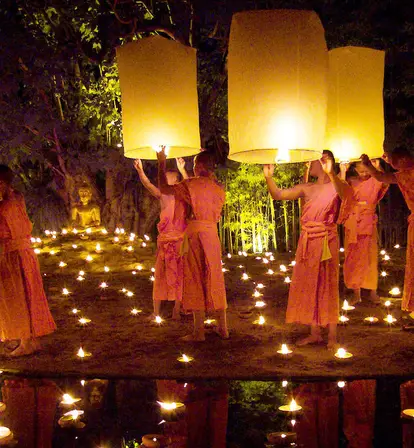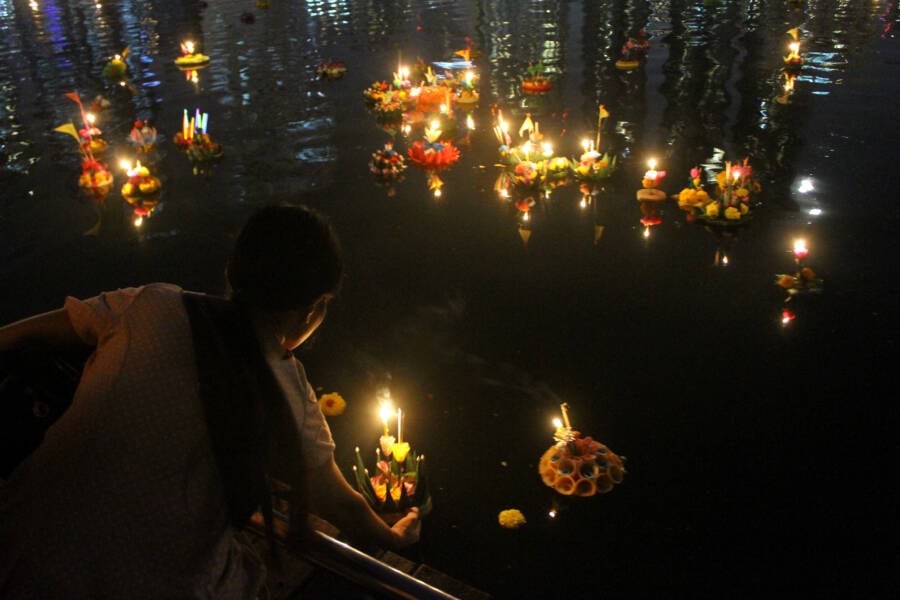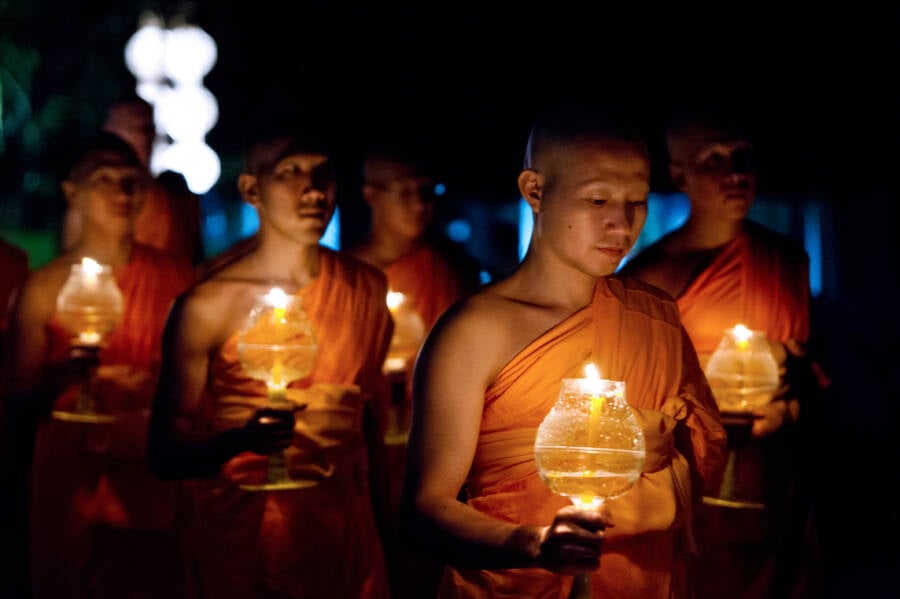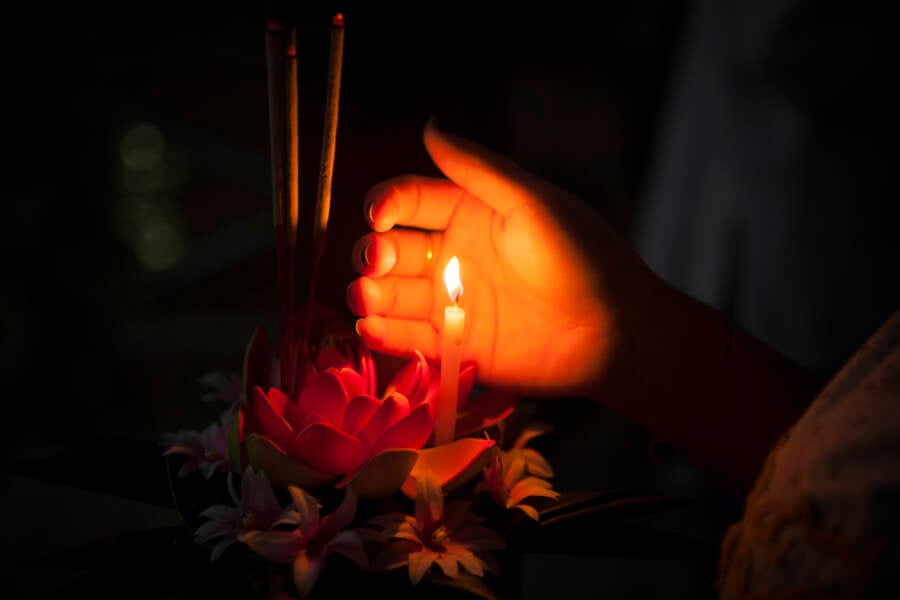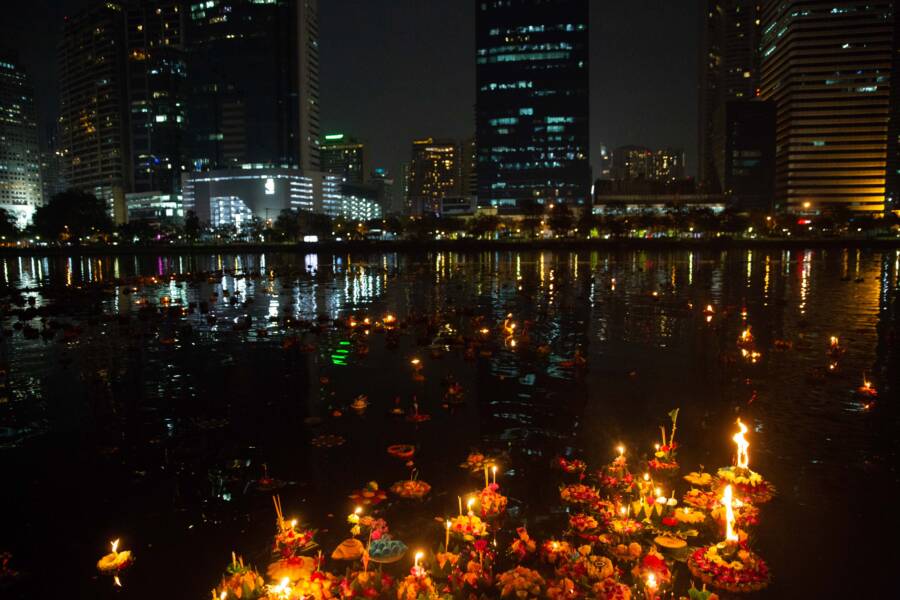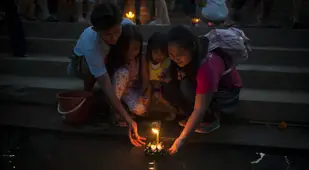Thousands of vibrantly decorated floating baskets light up the country's water ways to create a stunning sight.
Each year, locals and tourists in Thailand gather by the country's rivers, lakes, and ponds to celebrate Loy Krathong, a Siamese tradition made popular through the elaborate annual festivals in Thailand. Festival goers hand make or pick out vibrantly adorned baskets that carry incense, candles, or offerings to the water goddess and release them on to the water. In northern Thailand, the Loy Krathong festival is preceded by another breathtaking sight of sky lanterns at night during the Yi Peng celebrations that are distinct to the region.
The Origins Of Loy Krathong
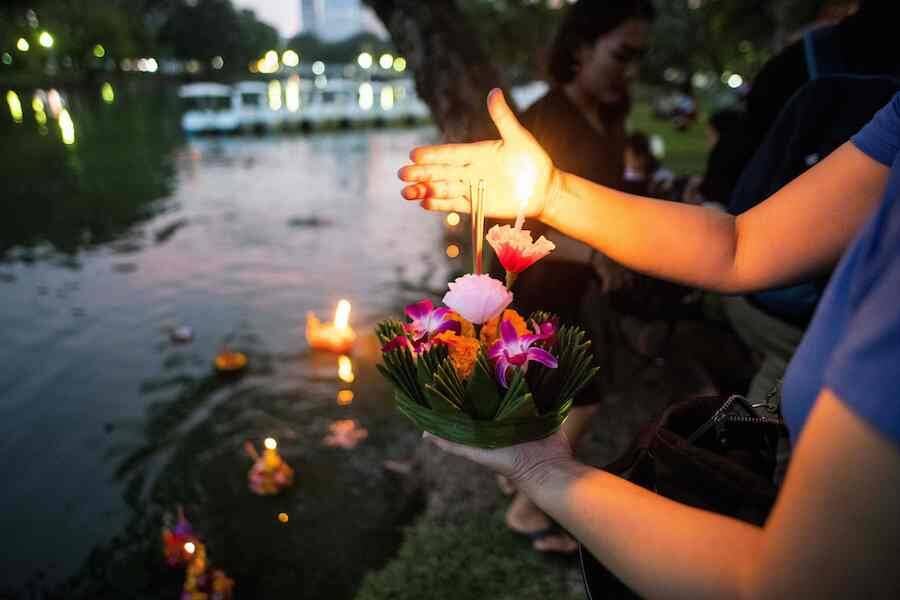
Jewel Samad/AFP/Getty ImagesA woman lights up her krathong before releasing it on a lake to celebrate the Loy Krathong festival in Bangkok.
The name Loy Krathong itself loosely translates to English as "floating basket," which refers to the tradition of releasing lotus-shaped baskets that float along the water. Although there has been no definitive consensus about the true origins of the Loy Krathong tradition, many believe that it originated from the ancient city of Sukhothai.
Sukhothai is located about five hours north of the Bangkok capital and continues to stand as a heritage site today. But back then, the kingdom of Sukhothai was first established in 1238 and was known as a prosperous and mighty civilization during ancient times.
According to local legends, a noble lady called Nang Noppamas, who was the daughter of a respected Brahmin priest and a close confidant to the king, was the first to hand make a krathong (which translates to small raft or basket) as a gift to his majesty.
Legend has it that Noppamas made the basket out of moulded banana leaves based on an existing Brahmin tradition. She bended the banana leaves into the shape of a lotus flower — which holds meaningful significance for Thai people as a symbol of purity and rebirth — before adding a candle and incense sticks.
The story goes that after receiving the beautiful gift, the king lit its candle and incense sticks, and released the krathong on one of the waterways nearby.
However, some historians say that Noppamas was simply a fictional character from olden times. She first appeared in a book written in the 18th Century but her influence and connection to the beloved Loy Krathong celebrations still continues. Many places in Thailand hold beauty contests and dance performances with their Loy Krathong festivities as a tribute to the admirable noble woman Nang Noppamas.
The Floating Krathong

Jewel Samad/AFP/Getty ImagesLoy Krathong is celebrated annually with Thais releasing lotus-shaped containers or baskets on the water.
Loy Krathong is one of Thailand's biggest festivals and celebrated during the full moon of the 12th month of the traditional Thai lunar calendar. If you are going by the Western calendar, Loy Krathong celebrations fall sometime in November when the rainy season comes to an end. Depending on the city or region, celebrations can take up to three days or longer.
Although it is considered more of a cultural custom than religious holiday, many Thais will include some sort of offering, like a coin, inside their beautifully decorated krathong as a gift to the water goddess, Mae Khongkha, or the Mother of Water, and make a wish or prayer.
Being a country that borders the ocean, water is an important element in Thai culture. It is believed that the krathong carries or "floats" away bad luck and signifies a fresh start for festival goers.
The krathong hold a vibrance of colorful flowers and decorations on top of a natural foundation typically made out of banana leaves that are folded and shaped into a lotus. They can also be made using tree bark or coconut shells depending on the celebration's region.
In the Western province of Tak which borders Myanmar, the coconut krathong are famous not only because of their unique shape and ingenuity, but also because they are considered an organic and sustainable material to create the floating baskets.
In Tak, coconut shells are cleaned thoroughly then filled with melted candle wax to keep the wick in place. The coconut krathong are tied together to create a line-up of candle-lit coconut floats called loy krathong sai which are released along the area's Ping river.
During the festivals, vendors sell krathong in all shapes, colors, and sizes. The classic shape is a banana leaf lotus but the more creative basket makers can concoct krathong in the shape of floating hearts and animals. The krathong are topped off with incense or candles, or both, which are lit before the basket is set on the water to float.
Because the aftermath of these vibrant festivals leave the water ways flooded with krathong, there has been a growing movement toward natural or biodegradable materials to make the baskets so that the water doesn't become heavily polluted. Krathong made out of plastic materials or styrofoam have been banned in many places in Thailand.
But no matter how a person chooses to make their basket, these floating krathong are meant to symbolize the release of one's misfortunes so that they may head down stream and go away for good. They are also meant to encourage community as festival organizers often have families or friends create their krathong together.
In the end, the sight of thousands brightly-lit krathong floating down the waterways of Thailand make for an unforgettable spectacle.
Northern Thailand's Yi Peng Festival
Travel further up to northern Thailand and you will reach the city of Chiang Mai, known among travelers for its serene mountains and historical relics left behind by the ancient Lanna Kingdom. Because of the distinct history with its Lanna people, northern Thailand is host to another breathtaking tradition that is celebrated along with the Loy Krathong festival.
Yi Peng is famously known outside of Thailand as the Chiang Mai lantern festival and is held to honor Lanna culture. Different to the Loy Krathong festival in which beautifully decorated baskets get released into the waters of Thailand, the Yi Peng festival involves sky lanterns — or khom loi — that are lit and released into the night sky.
The Yi Peng lantern festival falls on the same date as the Loy Krathong — during the full moon on the 12th month of the Thai lunar year — so celebrations of both Yi Peng and Loy Krathong take place alongside each other. The biggest Yi Peng celebrations are commonly held in Chiang Mai which is the former ancient capital of the old Lanna Kingdom.
While the krathong for the Loy Krathong festival are made out of banana leaves and other tropical resources, the khom loi or floating lanterns to celebrate Yi Peng are typically made out of rice paper that is stretched over bamboo lantern frames. Inside the lantern is where the center candle is located. After the candle is set on fire, the hot air from it gets trapped inside the lantern and makes the lantern float.

Atid Kiattisaksiri/LightRocket via Getty ImagesTo celebrate the Yi Peng festival, khom loi (or sky lantern) are released into the air.
It is said that if your lantern disappears out of sight before the light goes out, that is a sign of an extremely good year. But if your lantern gets destroyed or crashes, a year of bad luck is to be expected. Thais believe that making a wish before letting go of a sky lantern during Yi Peng will help any wish come true.
Sometimes festival goers will write sweet messages on the exterior of their lanterns though the scribbles become hardly visible once they are high up in the air.
Different kinds of lanterns can be found at the Yi Peng festival. In addition to khom loi, there are also khom fai and khom pariwat — the paper lanterns that adorn houses and temples — and khom tue — the lanterns that hang on a stick.
Thailand has deep roots in Buddhism. Many believe that the tradition of the Yi Peng lantern festival came from India. The legend goes that a candle-carrying bird visited the Buddha once and spoke to him. In this respect, the festival is considered a way to pay respects to the Buddha which according to the religion can help believers pave way to a splendid life of reincarnation.
The wondrous sight of tens of thousands of lit lanterns all sprinkled across the sky at once during the Yi Peng lantern festival attracts both locals and tourists who are eager to set their own lantern away.
Now that you've read about Thailand's festival of lights, take a look at the stunning photos from China and Vietnam's mid-autumn festival. And then, discover 33 photos from the Isle of Wight festival.
